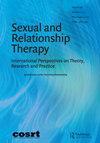扭曲的坦陀罗:现代关系沟通的古代精神实践的应用
IF 1.4
4区 心理学
Q3 PSYCHOLOGY, CLINICAL
引用次数: 1
摘要
密宗的实践被认为已经开始在第一个千年的中间CE[共同或当前的时代]在什么是现在的印度。我们今天所知道的密宗主要是通过《爱经》和《阿南伽Ranga》的作品保存下来的。然而,直到20世纪60年代,密宗实践在西方社会变得更加广为人知,并且从此变得越来越受欢迎。坦陀罗主要的西方化令人不安的是,它经常采取一种挪用的形式,而不是从文化的真实性或谦卑的立场上应用。例如,在东方文化背景下,密宗实践的大部分目标都集中在精神成长上,然而,在西方背景下,重点更多地放在性改善上。这种误解最终使密宗在人们的关系生活中可以发挥的强大作用最小化。尽管从业者和专业人士都认为密宗有价值,但很少有学术文献支持它的使用,而且自从以前发生的西方化浪潮以来,对密宗的理解很少有更新。为了解决这些已确定的差距,作者已经研究密宗知情实践并在国内和国际上举办了五年多的相关研讨会,他将通过知情立场讨论密宗知情实践,包括:以学术为基础的密宗简史,西方化和相关的密宗浪潮,对占有与应用思想的反思,描述和讨论现代密宗的应用,这些应用植根于联系,整合和关系沟通的初衷,包括概述作者研讨会上分享的技术和策略;以及这些做法如何被修改和应用于性治疗实践的知情使用。本文章由计算机程序翻译,如有差异,请以英文原文为准。
Tantra with a Twist: application of an ancient spiritual practice for modern relational communication
Abstract The practice of Tantra is believed to have started in the middle of the first millennium CE [common or current era] in what is now India. What we know of Tantra today has been primarily preserved through the works of the Kama Sutra and the Ananga Ranga. It was not until the 1960s, however, that Tantric practices became more well known in Western societies, and have become increasingly popular since. What is troubling about the predominant Westernization of Tantra is that it has frequently taken on a form of appropriation rather than application from a positionality of cultural genuineness or humility. For instance, much of the aim of Tantric practices in Eastern cultural contexts has focused on spiritual growth, however, in Western contexts the focus has been more on sexual improvement. This kind of misunderstanding ends up minimizing the powerful part that Tantra can play in people’s relational lives. Despite the value placed upon Tantra by practitioners and professionals alike, there is very little scholarly literature supporting its use, and there have been few updates to the understanding of Tantra since the waves of Westernization that have previously occurred. To address these identified gaps, the author, who has been studying Tantra-informed practices and hosting related workshops nationally and internationally for over five years, will discuss Tantric-informed practices through an informed position, including: the scholarly-based brief history of Tantra, Westernization and related waves of Tantra, a reflection on ideas of appropriation versus application, describing and discussing modern applications of Tantra that are rooted in the original intention of connection, integration, and relational communication, including an overview of the techniques and strategies shared in the author’s workshops, as well as how such practices can be modified and applied for informed use in the practicing of sex therapy.
求助全文
通过发布文献求助,成功后即可免费获取论文全文。
去求助
来源期刊

Sexual and Relationship Therapy
PSYCHOLOGY, CLINICAL-
CiteScore
3.80
自引率
9.10%
发文量
37
期刊介绍:
Sexual and Relationship Therapy is a leading independent journal in its field, well established and internationally recognized. It offers an active, multidisciplinary forum for review and debate across the spectrum of sexual and relationship dysfunctions and therapies. The journal presents original research and best practice and is a vehicle for new theory, methodology, and application. Sexual and Relationship Therapy is edited by a respected international team and publishes contributions from around the world. It is the official journal of the British Association for Sexual and Relationship Therapy (BASRT).
 求助内容:
求助内容: 应助结果提醒方式:
应助结果提醒方式:


